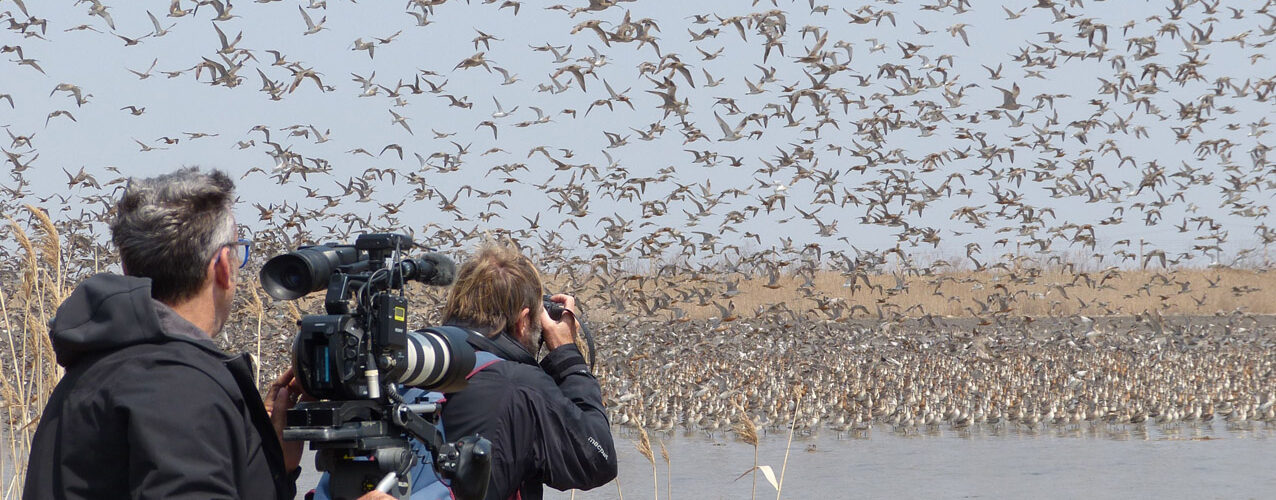
Each year thousands of shorebirds migrate between New Zealand and breeding grounds in Alaska and Siberia. The best known of these are bar-tailed godwits that make the longest non-stop flights of any land bird. Storing fat before they depart our shores in March, they then take a nonstop flight to tidal flats in the Yellow Sea region of China and Korea, where they stage for several weeks replenishing fuel reserves, before resuming the journey to the Alaskan tundra. After breeding they return to New Zealand directly across the Pacific – in flights of between 11,000 an 12,000 km in 8-10 days. This extraordinary feat is only possible if birds find sufficient food at all three points of their annual cycle. The collection of habitats used by such birds in Australasia, East Asia and the Arctic is known as the East Asian Australasian Flyway. For most birds the lynch pin of this system is the Yellow Sea. In recent decades colossal areas of tidal flat habitats around the Yellow Sea have been lost to development and pollution – the main reason why most migratory shorebird populations in the region are declining.
Join author and New Zealand Order of Merit recipient Keith Woodley as we hear about the work of Pūkorokoro Miranda Naturalists’ Trust, a community group based on the Firth of Thames, working in the Flyway for over 25 years. In 2004 the Trust established a sister-site partnership with Yalu Jiang National Nature Reserve in northern China, the major stopover site for bar-tailed godwits. Trust members contributed to annual shorebird counts there, which confirmed the site to be the most important staging site in the entire flyway. Working with international colleagues, Trust members also assisted with counts elsewhere in China and in South Korea. However, there remained a significant gap in their knowledge of the region. At the eastern end of the Yalu Jiang reserve, they would watch as large flocks disappeared across the Yalu River, to roost in North Korea. Would it ever be possible to follow them there? Since 2014, Trust members have done just that. Keith Woodley will talk about five years of shorebird surveys conducted by PMNT in that reclusive country, and the discovery of internationally important sites for shorebirds.
Thames, working in the Flyway for over 25 years. In 2004 the Trust established a sister-site partnership with Yalu Jiang National Nature Reserve in northern China, the major stopover site for bar-tailed godwits. Trust members contributed to annual shorebird counts there, which confirmed the site to be the most important staging site in the entire flyway. Working with international colleagues, Trust members also assisted with counts elsewhere in China and in South Korea. However, there remained a significant gap in their knowledge of the region. At the eastern end of the Yalu Jiang reserve, they would watch as large flocks disappeared across the Yalu River, to roost in North Korea. Would it ever be possible to follow them there? Since 2014, Trust members have done just that. Keith Woodley will talk about five years of shorebird surveys conducted by PMNT in that reclusive country, and the discovery of internationally important sites for shorebirds.
With a degree in politics and history it seems an unlikely career outcome, but Keith Woodley has been resident manager at Pūkorokoro Shorebird Centre since 1993. Operated by Pūkorokoro Miranda Naturalists’ Trust, it is an information and education centre on the southwest corner of the Firth of Thames. Keith is the author of three books: Godwits: long-haul champions (Penguin Raupo) 2009, Shorebirds of New Zealand: Sharing the margins (Penguin Raupo) 2012 and In Pursuit of Champions: the inspiring story of the Pūkorokoro Shorebird Centre (PMNT and Sherlock &Co) 2022. In 2022 he was made a member of the New Zealand Order of Merit for services to shorebird conservation.
Photo credits: Keith Woodley